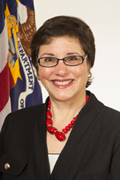Erica L. Groshen was the 14th Commissioner of Labor Statistics. She served from January 2013 to January 2017. This is her final post for Commissioner’s Corner.

It didn’t take long after I became Commissioner of Labor Statistics in January 2013 for me to appreciate the skill, dedication, and innovation of the staff that works here. Whether they’re doing sampling, data collection, estimation, or dissemination; whether they’re the IT professionals or the statisticians or the HR staff; whether they’re the newest employees who are so tech-savvy or the more senior employees who hold a wealth of institutional knowledge. To a person they are phenomenal. I am honored to have had the pleasure of leading them — and letting them lead me — during the past 4 years.
I have had many opportunities to observe and encourage innovation during my tenure at the U.S. Bureau of Labor Statistics, from listening tours to senior staff conferences to regional office visits to discussions with a wide variety of stakeholders. From these efforts, we have identified several activities that will help us develop and implement the next generation of labor statistics. These days, we call these efforts a variety of names, such as “modernization” and “reengineering.” But, in truth, they just continue the impressive progress that has been the hallmark of BLS for the past 133 years.
In my final Commissioner’s Corner post, I want to tell you a little about some of our current reengineering efforts.
One of the things we do best at BLS is data collection, largely because we are always looking for ways to improve. Recent efforts include identifying alternative data sources, expanding electronic collection, and “scraping” information directly from the Internet. These efforts can expand the information we provide, lessen the burden we place on employers and households that provide data, and maybe even save some money to provide taxpayers the best value for their data dollar.
These efforts are not new. One source of alternative data we’ve used for many years comes from state unemployment insurance filings, which identify nearly every employer in the country. We tabulate these data but also use them as the source of our sample of employers for certain surveys and as a benchmark of detailed employment by industry. We also use information from private sources and from administrative sources, like vital statistics. Our latest efforts involve examining techniques to combine data across multiple sources, including mixing survey and nonsurvey data.
We want to give employers the opportunity to leverage the electronic data they already keep so it’s easier to respond to our surveys. These efforts include allowing employers to provide electronic information in multiple formats; identifying a single source of electronic data from employers, reducing the number of locations and number of requests made to multiple sites of the same organization; and working with employers to allow BLS to access their data directly from the Internet. We rely on good corporate citizens to supply the information that we use to produce important economic data. Making data collection easier is a win-win.
The innovation doesn’t stop at collection. We are using electronic text analysis systems extensively to streamline some of our data-processing activities. Much of the information we collect is in the form of text, such as a description of an industry or occupation, details about a workplace injury, or summaries of employee benefit plans. Transforming text into a classification system for tabulation and publication used to be a manual task. BLS has begun to transform this task through the use of machine-learning techniques, where computers learn by reviewing greater and greater amounts of information, resulting in accurate classification. As we expand our skills in this area and find more uses for these techniques, the benefits include accurate and consistent data and greater opportunities for our staff to use their brainpower to focus on new, unique, and unusual situations.
We are also modernizing our outputs, producing more with the information we have. For example, we have begun several matching projects, combining data from two or more sources to produce new information. One example is new information on nonprofit organizations. By linking our employment data with nonprofit status obtained from the Internal Revenue Service, we now have employment data separately for the for-profit and nonprofit sectors. And we took that effort one step further and produced compensation information for these sectors as well. Look for more output from these matching efforts in the future.
Finally, we’ve made great strides in how we present our information, including expanded graphics and video. And we are not stopping there. Each year we are expanding the number of data releases that include a companion graphics package. We are developing prototypes of a new generation of data releases, with more graphics and links to data series. And we have more videos to come.
My 4 years as Commissioner of Labor Statistics have flown by. I’m excited to see so many innovations begin, thrive, and foster additional innovations. I have no doubt that the culture of innovation at BLS will continue. As my term comes to an end, I know now more than ever that the skill, dedication, and creativity of the BLS staff will lead this agency to even greater advances in the years to come.
 United States Department of Labor
United States Department of Labor